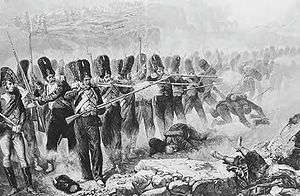Six Days' Campaign order of battle
The Six Days' Campaign saw four victories by the Imperial French army led by Napoleon over the Army of Silesia commanded by Prussian Field Marshal Gebhard Leberecht von Blücher. Between 10 and 15 February 1814, the French inflicted losses of at least 14,034 men and 52 guns on the Army of Silesia. A second estimate listed 16,000 casualties and 60 guns. A third estimate reached as high as 20,000 casualties, but a calculation by historian George Nafziger suggested that Blücher may have lost 28,500 soldiers.[1]
After their victory over Napoleon in the Battle of La Rothière on 1 February 1814, the two main Allied armies separated. Austrian Field Marshal Karl Philipp, Prince of Schwarzenberg's Army of Bohemia marched west toward Troyes while Blücher's Army of Silesia moved north to Châlons-sur Marne and turned west along the Marne River, aiming for Meaux.[2] Leaving 39,000 troops to watch the cautious Schwarzenberg, Napoleon assembled a strike force of 20,000 infantry and 10,000 cavalry to deal with the more aggressive Blücher.[3] By the evening of 8 February, the Army of Silesia was spread along a line of march 44 miles (71 km) long. Fabian Gottlieb von Osten-Sacken's 20,000 Russians led the column, followed by Ludwig Yorck von Wartenburg's 18,000 Prussians, Zakhar Dmitrievich Olsufiev's 4,000 Russians, Peter Mikhailovich Kaptzevich's Russians and Friedrich Graf Kleist von Nollendorf's Prussians, the last two forces totaling 15,000 men.[4]
Organization
Russian
The Russian forces were organized into army corps with infantry corps and cavalry corps subordinated to it. The full structure can be seen in the Sacken's Russian order of battle section.[5] The Russian IX Infantry Corps, as shown in the Olsufiev's Russian order of battle section, and the Russian X Corps, as shown in the Kaptzevich's Russian order of battle section, both reported to their superior, General-Leutnant Louis Alexandre Andrault de Langeron.[6] Since Langeron did not appear in the theater of operations until late February, they temporarily reported directly to Blücher.[7]
In the Russian army, artillery batteries were organized with 12 pieces each. In 1805, Aleksey Arakcheyev introduced a new range of field artillery that consisted of 6- and 12-pounder cannons and 10- and 20-pounder licornes, a gun similar to a howitzer.[8] An Allied order of battle from 1 January 1814 noted that Light Batteries were armed with 6-pounders. The same list stated that of five Position Batteries in one army corps, three had 12 guns, one had 11 guns, and one had seven guns.[9] In the Russian 3rd Dragoon Division, Horse Battery Nr. 18 was armed with only 10 guns, but usually the specific number of guns in a battery was not stated.[10]
Prussian
When the Prussian army was rebuilt after the disastrous War of the Fourth Coalition, its reduced establishment did not allow for the formation of divisions. Therefore, the next tactical unit below corps level became the brigade, which included both cavalry and artillery. Batteries were formed from six 6- or 12-pounder cannons and two 7- or 10-pounder howitzers. Artillery batteries that were not assigned to the brigades were posted to the corps reserve.[11] By 1813, each corps incorporated four brigades and included a mix of regular and Landwehr units.[12]
French
A French order of battle from 6 January 1814 showed 10 Young Guard Foot Artillery and one Old Guard Foot Artillery companies each armed with six 6-pounder guns and two howitzers. There were four Old Guard Foot Artillery companies armed with six 12-pounder guns and two howitzers. Six Old Guard Horse Artillery companies were each armed with four 6-pounder guns and two howitzers.[13] Eight guns per foot artillery company and six guns per horse artillery company represented the standard French organization.[14] However, at the Battle of La Rothière on 1 February, the Allies captured 50–60 French guns. Which artillery companies lost guns was not stated.[15]
Battle of Champaubert
Napoleon with 30,000 men and 120 guns surprised Olsufiev south of Champaubert on the morning of 10 February. Unwisely, Olsufiev decided to fight it out, hoping for help from Blücher. By 3:00 pm the Russians were forced back through Champaubert. Too late, Olsufiev tried to retreat east to Étoges, but found both flanks enveloped by French cavalry. Olsufiev lost as many as 4,000 men out of 5,000 troops,[16] or as few as 2,400 and nine guns out of a total of 3,700 men and 24 guns. Olsufiev and Prince Konstantin Poltoratsky ended the day as French prisoners. French losses were about 600.[17]
Olsufiev's Russian order of battle
| Corps | Division | Brigade | Regiment | Strength |
|---|---|---|---|---|
| IX Infantry Corps Lieutenant General Zakhar Dmitrievich Olsufiev (POW)  |
IX Corps Artillery | Not Brigaded | Position Battery Nr. 15 not present | 12 guns |
| Light Battery Nr. 13 | 12 guns | |||
| Light Battery Nr. 24 | 12 guns | |||
| 9th Infantry Division General-major Evstafi Evstafievich Udom II |
General-major Konstantin Poltoratsky (POW) | Apsheron Infantry Regiment | 486 | |
| Nacheburg Infantry Regiment | 563 | |||
| General-major Juschkov II | Riazsk Infantry Regiment | 620 | ||
| Yakutsk Infantry Regiment | 533 | |||
| Major Melnik | 10th Jäger Regiment | 335 | ||
| 38th Jäger Regiment | 472 | |||
| 15th Infantry Division General-major Peter Yakovlevich Kornilov |
Lieutenant Colonel Anensur | Vitebsk Infantry Regiment | 372 | |
| Kozlov Infantry Regiment | 504 | |||
| General-major Mussin-Pushkin | Kolyvan Infantry Regiment | 417 | ||
| Kourin Infantry Regiment | 417 | |||
| Colonel Tuchanowski | 12th Jäger Regiment | 447 | ||
| 22nd Jäger Regiment | unknown | |||
French Army order of battle
Commander-in-chief: Emperor Napoleon
Chief of Staff: Marshal Louis-Alexandre Berthier
The units available to fight at Champaubert were the 1st Old Guard Division, the Guard artillery, the 1st and 3rd Guard Cavalry Divisions, the 1st and 2nd Young Guard Divisions, both divisions of the VI Corps, both divisions of the I Cavalry Corps, and Cyrille-Simon Picquet's cavalry brigade.[19]
After General of Division Pierre Decouz was killed at the Battle of Brienne, General of Brigade Jean-Jacques Germain Pelet-Clozeau temporarily commanded the 2nd Young Guard Division through the battles of 10–11 February. Then he was reassigned to lead a brigade in the 1st Old Guard Division.[20]
| Corps | Division | Strength | Brigade | Regiment | Strength |
|---|---|---|---|---|---|
| Old Guard Marshal Édouard Mortier 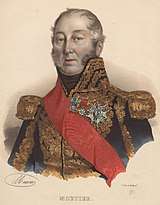 |
1st Old Guard Division General of Division Louis Friant |
4,796 | 1st Brigade General of Brigade Pierre Cambronne |
1st Guard Foot Chasseur Regiment, 1st & 2nd Battalions | 1,265 |
| 2nd Guard Foot Chasseur Regiment, 1st & 2nd Battalions | 898 | ||||
| 2nd Brigade General of Brigade Jean Martin Petit |
1st Guard Foot Grenadier Regiment, 1st & 2nd Battalions | 1,393 | |||
| 2nd Guard Foot Grenadier Regiment, 1st & 2nd Battalions | 1,044 | ||||
| Attached units | Guard Sapper Battalion, 1st, 2nd & 3rd Companies | 105 | |||
| Guard Marine Battalion, 3rd Company | - | ||||
| Guard Engineering Train | - | ||||
| 2nd Old Guard Division General of Division Claude-Étienne Michel (WIA) followed by: Charles-Joseph Christiani |
3,878 6 guns |
General of Brigade Jean Louis Gros |
Fusilier-Chasseur Regiment | 1,366 | |
| Fusilier-Grenadier Regiment | 688 | ||||
| General of Brigade Charles-Joseph Christiani |
Flanqueuer-Chasseur Regiment | 1,042 | |||
| Flanqueuer-Grenadier Regiment | 285 | ||||
| Velites of Turin | 333 | ||||
| Velites of Florence | 164 | ||||
| Artillery Captain Eggerlé |
1st Young Guard Company 4 6-pounder guns & 2 24-pound howitzers | 73, 6 guns | |||
| Guard Train Detachment | 81 | ||||
| Artillery | 1,464 | Not Brigaded | Guard Foot Artillery, 7 companies | 459 | |
| Horse Artillery, 4 companies | 319 | ||||
| Train and pontooneers | 686 | ||||
| Young Guard Marshal Michel Ney  |
1st Young Guard Division General of Division Claude Marie Meunier |
4,133 | 1st Brigade General of Brigade Jean Étienne Clément-Lacoste |
1st Voltiguer Regiment, 1st & 2nd Battalions | 657 |
| 2nd Voltiguer Regiment, 1st & 2nd Battalions | 940 | ||||
| 2nd Brigade General of Brigade Guillaume-Charles Rousseau |
3rd Voltiguer Regiment, 1st & 2nd Battalions | 1,263 | |||
| 4th Voltiguer Regiment, 1st & 2nd Battalions | 1,144 | ||||
| 2nd Young Guard Division General of Division Philibert Jean-Baptiste Curial |
2,840 | 1st Brigade General of Brigade Jean-Jacques Pelet |
5th Voltiguer Regiment, 1st & 2nd Battalions | 680 | |
| 6th Voltiguer Regiment, 1st & 2nd Battalions | 633 | ||||
| 2nd Brigade General of Brigade Auguste Julien Bigarré |
7th Voltiguer Regiment, 1st & 2nd Battalions | 717 | |||
| 8th Voltiguer Regiment, 1st & 2nd Battalions | 670 | ||||
| Guard Cavalry General of Division Étienne de Nansouty 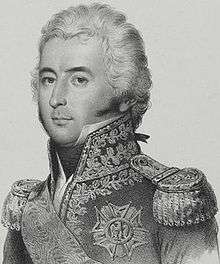 |
1st Guard Cavalry Division General of Division Pierre de Colbert |
2,582 | Brigades unknown | 2nd Éclaireur Regiment | - |
| 2nd Chevau-léger Lancer Regiment | - | ||||
| Guard Chasseurs à Cheval Regiment | - | ||||
| Guard Horse Grenadier Regiment | - | ||||
| Guard Dragoon Regiment | - | ||||
| 2nd Guard Cavalry Division General of Division Charles Lefebvre-Desnouettes |
3,535 | Brigades unknown | 1st Guard Lancer Regiment | 680 | |
| Guard Chasseurs à Cheval Regiment | 667 | ||||
| Guard Dragoon Regiment | 800 | ||||
| Guard Horse Grenadier Regiment | 954 | ||||
| Gendarmes d'Elite Regiment | 434 | ||||
| 3rd Guard Cavalry Division General of Division Louis Laferrière-Levêque |
2,164 | 1st Brigade General of Brigade Jean Dieudonné Lion |
Guard Chasseurs à Cheval Regiment | 542 | |
| Guard Dragoon Regiment | 735 | ||||
| 2nd Brigade General of Brigade Louis-Michel Letort de Lorville |
Guard Horse Grenadier Regiment | 887 | |||
| I Cavalry Corps General of Division Jean-Pierre Doumerc  followed by: Étienne de Bordesoulle |
1st Light Cavalry Division General of Division Christophe Antoine Merlin |
704 | 1st Brigade General of Brigade François Isidore Wathiez |
6th, 7th & 8th Hussar Regiments 1st, 3rd, 5th & 8th Chevau-léger Lancier Regiments 16th Chasseurs à Cheval Regiment | 272 |
| 2nd Brigade General of Brigade Claude Raymond Guyon |
1st, 2nd & 3rd Chasseurs à Cheval Regiments 6th & 8th Chasseurs à Cheval Regiments 9th & 25th Chasseurs à Cheval Regiments | 432 | |||
| 2nd Heavy Cavalry Division General of Division Étienne de Bordesoulle |
1,196 | 1st Brigade General of Brigade Nicolas Marin Thiry |
2nd & 3rd Cuirassier Regiments 6th & 9th Cuirassier Regiments 11th & 12th Cuirassier Regiments | 614 | |
| 2nd Brigade General of Brigade Joseph Alexandre Félix de Laville |
4th, 7th & 14th Cuirassier Regiments 7th & 23rd Dragoon Regiments 28th and 30th Dragoon Regiments | 582 | |||
| Attached Artillery | 170 6 guns |
Not Brigaded | 1st Horse Artillery Regiment, 3rd Company | 77, 6 guns | |
| 1st (bis) Train Battalion, 2nd Company 8th (bis) Train Battalion | 93 | ||||
| II Cavalry Corps General of Division Antoine de Saint-Germain |
2nd Light Cavalry Division General of Division Sigismond Frédéric de Berckheim |
977 | 3rd Brigade General of Brigade Jean-Baptiste Dommanget |
5th & 9th Hussar Regiments 11th & 12th Chasseurs à Cheval Regiments 2nd & 4th Chevau-léger Lancer Regiments | 117 |
| 4th Brigade General of Brigade Jean-Baptiste Jamin de Bermuy |
6th Chevau-léger Lancer Regiment 4th, 7th & 20th Chasseurs à Cheval Regiments 23rd & 24th Chasseurs à Cheval Regiments | 860 | |||
| 2nd Heavy Cavalry Division General of Division Antoine de Saint-Germain |
665 | 3rd Brigade General of Brigade Amable Guy Blanchard |
1st Carabinier Regiment 2nd Carabinier Regiments 1st Cuirassier Regiment | 390 | |
| 4th Brigade General of Brigade Louis Charles Sopransi |
5th & 8th Cuirassier Regiments 10th & 13th Cuirassier Regiments | 275 | |||
| Corps Artillery Lieutenant Colonel Graillat |
270 4 guns |
Not Brigaded | 1st Horse Artillery, 1st Company 5th Horse Artillery, 5th Company 1st (bis) Train Battalion | 270, 4 guns | |
| Independent Cavalry | Cavalry Division General of Division Jean-Marie Defrance |
896 | General of Brigade Cyrille-Simon Picquet |
10th Hussar Regiment | - |
| 1st Gardes d'Honneur Regiment | - | ||||
| General of Brigade Philippe Paul, comte de Ségur |
2nd Gardes d'Honneur Regiment | - | |||
| 3rd Gardes d'Honneur Regiment | - | ||||
| 4th Gardes d'Honneur Regiment | - | ||||
| VI Corps Marshal Auguste de Marmont 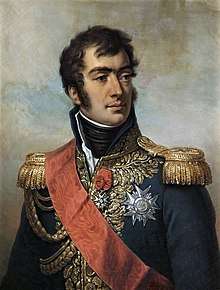 |
3rd Infantry Division General of Division Joseph Lagrange |
4,868 | General of Brigade Joseph Antoine René Joubert |
1st & 15th Line Infantry Regiments | - |
| 16th & 62nd Line Infantry Regiments | - | ||||
| 70th & 121th Line Infantry Regiments | - | ||||
| 1st Marine Regiment, 1st & 2nd Battalions | - | ||||
| General of Brigade Pierre Pelleport |
2nd Marine Regiment, 1st–4th Battalions | - | |||
| 3rd Marine Regiment, 1st–3rd Battalions | - | ||||
| 4th Marine Regiment, 1st–3rd Battalions | - | ||||
| 23rd Line Infantry Regiment, 3rd Battalion | - | ||||
| 37th Line Infantry Regiment, 1st & 3rd Battalions | - | ||||
| 8th Infantry Division General of Division Étienne Pierre Ricard |
2,917 | General of Brigade Jean-Louis Fournier |
2nd & 6th Light Infantry Regiments, 2nd Battalions | - | |
| 4th Light Infantry Regiment, 7th Battalion | - | ||||
| 9th & 16th Light Infantry Regiments | - | ||||
| 40th Line Infantry Regiment, 2nd Battalion | - | ||||
| 50th Line Infantry Regiment, 1st Battalion | - | ||||
| General of Brigade François-Louis Boudin de Roville (WIA) |
22nd & 69th Line Infantry Regiments | - | |||
| 136th & 138th Line Infantry Regiments, 1st Battalions | - | ||||
| 142nd Line Infantry Regiment, 1st Battalions | - | ||||
| 144th & 145th Line Infantry Regiments, 1st Battalions | - | ||||
| Corps Artillery | 775 30 guns |
Not Brigaded | 3rd Foot Artillery, 6th, 23rd & 25th Companies 4th Foot Artillery, 2nd & 11th Companies 5th Foot Artillery, 13th–16th & 27th Companies 8 12-pound cannons 13 6-pound cannons & howitzers | 266, 21 guns | |
| 1st Horse Artillery, 2nd Company 3rd Horse Artillery, 7th Company 5th Horse Artillery, 8th Company 9 6-pound cannons & howitzers | 156, 9 guns | ||||
| 3rd, 8th (bis), & 12th Train Battalions, 1 company each 4th Train Battalion, 1st & 4th Companies 9th (bis) Train Battalion, 1st & 5th Companies | 353 | ||||
| VII Corps Marshal Nicolas Oudinot not present  |
7th Division General of Division Jean François Leval |
4,500 | General of Brigade Pierre Armand Pinoteau |
10th Light Infantry Regiment, 1st & 2nd Battalions | - |
| 3rd Line Infantry Regiment, 1st Battalion | - | ||||
| 5th Line Infantry Regiment, 1st Battalion | - | ||||
| 130th Line Infantry Regiment, 1st & 4th Battalions | - | ||||
| General of Brigade Jacques Montfort |
17th Light Infantry Regiment, 1st Battalion | - | |||
| 101st Line Infantry Regiment, 1st Battalion | - | ||||
| 105th Line Infantry Regiment, 1st & 2nd Battalions | - | ||||
| Divisional Artillery | 2 Foot Artillery Companies | - | |||
| 1 Horse Artillery Company | - | ||||
Battle of Montmirail
On 11 February, Napoleon marched west through Montmirail with 10,500 men, consisting of the Old Guard, Étienne Pierre Sylvestre Ricard's division, and 36 guns. The French faced Fabian Wilhelm von Osten-Sacken's 18,000 Russians[22] (with 80[23] or 90 guns[24])[note 1] and Ludwig Yorck von Wartenburg's 18,000 Prussians. Sacken tried to force his way to the west, but Yorck's troops were delayed. By 4:00 pm, Napoleon's strength rose to 20,000. The French defeated Sacken's corps while Marshal Édouard Mortier repelled Yorck's belated attack.[22] Sacken lost 2,000 killed and wounded plus 800 men, 13 guns, and six colors captured. The Prussians sustained 900 casualties while the French lost 2,000.[25] French Generals Claude-Étienne Michel and François-Louis Boudin de Roville and Prussian General Otto Karl Lorenz von Pirch were wounded.[26]
Sacken's Russian order of battle
General-Leutnant Fabian Wilhelm von Osten-Sacken
| Corps | Division | Brigade | Regiment |
|---|---|---|---|
| Reserve Artillery | General-major Alexey Petrovich Nikitin |
Not Brigaded | Position Battery Nr. 10 |
| Position Battery Nr. 13 | |||
| Position Battery Nr. 18 | |||
| Light Battery Nr. 28 | |||
| VI Infantry Corps General-Leutnant Alexei Grigorievich Scherbatov (sick) General-major Alexander Ivanovich Tallisin II  |
7th Division General-major Nikolay Gregoryevich Scherbatov II |
Colonel Kritschinikov | Moscow Infantry Regiment, 1 battalion |
| Pskov Infantry Regiment, 1 battalion | |||
| Colonel Augustov | Libau Infantry Regiment, 1 battalion | ||
| Sophia Infantry Regiment, 1 battalion | |||
| Colonel Dietrich | 11th Jäger Regiment, 1 battalion | ||
| 36th Jäger Regiment, 1 battalion | |||
| 18th Division General-major Bernodessov |
Lieutenant Colonel Blagovenzenko | Dnieper Infantry Regiment, 1 battalion | |
| Vladimir Infantry Regiment, 1 battalion | |||
| General-major Heidenreich (POW) | Kostroma Infantry Regiment, 1 battalion | ||
| Tambov Infantry Regiment, 1 battalion | |||
| General-major Metcherinov | 28th Jäger Regiment, 1 battalion | ||
| 32nd Jäger Regiment, 1 battalion | |||
| VI Corps Artillery | Not Brigaded | Light Battery Nr. 19 | |
| Light Battery Nr. 24 | |||
| XI Infantry Corps General-major Ivan Andreievich Lieven III 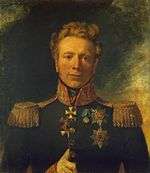 |
10th Division General-major Andrey Andreevich Zass I |
General-major Josif Karlovich Sokolovsky |
Yaroslavl Infantry Regiment, 1 battalion |
| Kursk Infantry Regiment, 1 battalion | |||
| Bieloserk Infantry Regiment, 2 battalions | |||
| Colonel Achlestischev | 8th Jäger Regiment, 1 battalion | ||
| 39th Jäger Regiment, 1 battalion | |||
| Lieutenant Colonel Selivanov Attached from 16th Division |
Kamchatka Infantry Regiment, 1 battalion | ||
| Okhotsk Infantry Regiment, 1 battalion | |||
| 27th Division General-Leutnant Maxim Fyodorovich Stavitsky |
Colonel Lewandowsky | Odessa Infantry Regiment, 1 battalion | |
| Vilna Infantry Regiment, 1 battalion | |||
| Colonel Alexejev | Simbirsk Infantry Regiment, 1 battalion | ||
| Tarnopol Infantry Regiment, 1 battalion | |||
| Colonel Kalogruivoff | 49th Jäger Regiment, 1 battalion | ||
| 50th Jäger Regiment, 1 battalion | |||
| XI Corps Artillery | Not Brigaded | Light Battery Nr. 34 | |
| Light Battery Nr. 35 | |||
| Cavalry Corps General-Leutnant Ilarion Vasilievich Vasilshikov 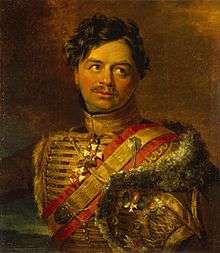 |
2nd Hussar Division General-major Sergei Nicholaevich Lanskoi |
General-major Ivan Mikhailovich Vadbolsky |
Akhtyrsk Hussar Regiment, 6 squadrons |
| Marioupol Hussar Regiment, 5 squadrons | |||
| Colonel Dmitri Vasilievich Vasilshikov II |
White Russia Hussar Regiment, 4 squadrons | ||
| Alexandria Hussar Regiment, 5 squadrons | |||
| 3rd Dragoon Division General-major Semyon Davydovich Pandschulishev |
General-major Pavel Nicolaevich Ushakov II |
Smolensk Dragoon Regiment | |
| Kurland Dragoon Regiment | |||
| General-major Andrey Semyonovich Umanets |
Tver Dragoon Regiment | ||
| Kinburn Dragoon Regiment | |||
| Not Brigaded | Horse Artillery Battery Nr. 18, 10 guns[10] | ||
| Cossacks General-major Akim Akimovich Karpov II |
Not Brigaded | Karpov II Don Cossack Regiment | |
| Semintschikov IV Don Cossack Regiment | |||
| Lukovken II Don Cossack Regiment | |||
| Kuteinikov IV Don Cossack Regiment | |||
| Grekov I Don Cossack Regiment | |||
| St Petersburg Opolchenie Cossack Regiment | |||
| 4th Ukrainian Cossack Regiment | |||
| 2nd Kalmuck Regiment | |||
| Cavalry Corps Artillery | Not Brigaded | Horse Artillery Battery Nr. 6 | |
| Horse Artillery Battery Nr. 7 | |||
Yorck's Prussian order of battle
The 1st Brigade under General-major Otto Karl Lorenz von Pirch and the 7th Brigade under General-major Heinrich Wilhelm von Horn were engaged.[27] The only Prussian artillery present were the two batteries attached to the 1st and 7th Brigades. The remainder of the artillery was unable to get forward because of poor condition of the roads. The 8th Brigade was sent back to hold Château-Thierry in case of an attack by Marshal Jacques MacDonald.[28]
| Corps | Brigade | Strength | Regiment |
|---|---|---|---|
| I Corps General of the Infantry Ludwig Yorck von Wartenburg  |
1st Brigade General-major Otto Karl Lorenz von Pirch |
3,505 | 1st East Prussian Grenadier Battalion |
| Silesian Grenadier Battalion | |||
| Leib Grenadier Battalion | |||
| West Prussian Grenadier Battalion | |||
| 339 | Foot Jägers | ||
| 4,826 | 13th Silesian Landwehr Regiment, 4 battalions | ||
| 728 | East Prussian National Cavalry Regiment, 4 squadrons (+148 Jägers) | ||
| 96 | 6-pounder Foot Artillery Battery Nr. 2 | ||
| 2nd Brigade Oberst Friedrich Wilhelm von Warburg |
4,777 | 1st East Prussian Regiment, 3 battalions | |
| 2nd East Prussian Regiment, 3 battalions | |||
| 197 | Foot Jägers | ||
| 469 | Mecklinburg-Strelitz Hussar Regiment, 4 squadrons (+46 Jägers) | ||
| 94 | 6-pounder Foot Artillery Battery Nr. 1 | ||
| 7th Brigade General-major Heinrich Wilhelm von Horn |
2,688 | Leib Infantry Regiment, 3 battalions | |
| 278 | Foot Jägers | ||
| 4,589 | 5th Silesian Landwehr Regiment, 2 battalions | ||
| 15th Silesian Landwehr Regiment, 2 battalions | |||
| 492 | Brandenburg Hussar Regiment (+200 Jägers) | ||
| 114 | 6-pounder Foot Artillery Battery Nr. 3 | ||
| 8th Brigade General-major Prince Wilhelm of Prussia |
4,726 | Brandenburg Infantry Regiment, 3 battalions | |
| 12th Reserve Infantry Regiment, 2 battalions | |||
| 2,102 | 12th Silesian Landwehr Regiment, 2 battalions | ||
| 382 | 2nd Leib Hussar Regiment (+84 Jägers) | ||
| 97 | 6-pounder Foot Artillery Battery Nr. 15 | ||
| Reserve Cavalry Oberst Georg Ludwig von Wahlen-Jürgass |
2,031 Line 318 Jägers |
Henkel's Brigade: Lithuanian Dragoon Regiment | |
| Henkel's Brigade: 1st West Prussian Dragoon Regiment | |||
| Katzler's Brigade: Brandenburg Uhlan Regiment | |||
| 1,341 | Katzler's Brigade: 1st Neumark Landwehr Cavalry Regiment | ||
| Bieberstein's Brigade: 5th Silesian Landwehr Cavalry Regiment | |||
| Bieberstein's Brigade: 10th Silesian Landwehr Cavalry Regiment | |||
| 327 | 6-pounder Horse Artillery Battery Nr. 1 | ||
| 6-pounder Horse Artillery Battery Nr. 2 | |||
| Reserve Artillery Oberst von Schmidt |
522 | 12-pounder Foot Artillery Battery Nr. 1 | |
| 12-pounder Foot Artillery Battery Nr. 2 | |||
| 6-pounder Horse Artillery Battery Nr. 3 | |||
| 6-pounder Horse Artillery Battery Nr. 12 | |||
| Park Column Nr. 15 | |||
| 133 | Pioneers | ||
French order of battle
At Montmirail, Napoleon had the 1st and 2nd Old Guard Divisions, the 1st and 2nd Young Guard Divisions, the 1st, 2nd, and 3rd Guard Cavalry Divisions, Defrance's Cavalry Division, and Ricard's division.[30] Marshal Marmont took position at Étoges with Lagrange's division and the I Cavalry Corps with orders to observe Blücher.[31] Charles Lefebvre-Desnouettes led either the 2nd Guard Cavalry Division or the 3rd Young Guard Division; it is unclear.[30]
Battle of Château-Thierry
After being beaten by Napoleon's army at Montmirail, the corps of Sacken and Yorck withdrew toward Château-Thierry. When the Allied rearguard tried to hold off the French pursuit, Marshal Ney scattered the cavalry protecting the Allied left flank. The Prussian infantry escaped across the Marne River, but the French trapped a Russian brigade on the right flank and forced it to surrender. For the loss of 600 killed and wounded, the French inflicted 1,250 casualties on the Prussians and 1,500 casualties on the Russians. The French captured nine guns and many wagons. The Allies retreated to Fismes while the French repaired the broken bridge.[32] The next day, Marshal Mortier led the pursuit with the divisions of Christiani, Colbert, and Defrance. The French captured 300–400 stragglers while as many as 2,000 more were turned in by groups of French farmers, who were infuriated by Allied plundering during the previous week.[33]
French order of battle
On the morning of the battle, Saint-Germain reinforced Napoleon with 2,400 horsemen belonging to the II Cavalry Corps. Marshal MacDonald had destroyed the Trilport bridge over the Marne, which was on the direct route from Meaux to Montmirail. Therefore, the marshal sent Saint-Germain on a detour through Coulommiers to reach the main army.[25] As on the previous day, Marmont's 4,000 soldiers continued to watch Blücher.[34]
Battle of Vauchamps
Napoleon found that Blücher drove Marmont's force from Étoges and decided to move against the Prussian field marshal. The French emperor left Château-Thierry at 3:00 am on 14 February for a rendezvous with Marmont. That morning, Blücher advanced west to Vauchamps where he ran into stiff resistance. Blücher decided to retreat after seeing the French cavalry defeat the Allied cavalry and discovering that he was facing Napoleon in person. The 25,000 French enjoyed a numerical advantage over the 20,000 Allied soldiers. By the end of the day, the French inflicted 7,000 casualties on their enemies and captured 16 guns; French losses were only 600.[35] The losses include the remnant of Olsufiev's corps which lost 600 men and all its remaining artillery.[36]
Kaptzevich's Russian order of battle
| Corps | Division | Brigade | Regiment |
|---|---|---|---|
| X Infantry Corps General-Leutnant Peter Mikhailovich Kaptzevich 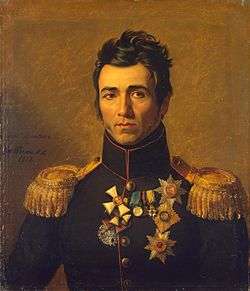 |
X Corps Artillery | Not Brigaded | Position Battery Nr. 39 |
| Light Battery Nr. 3 | |||
| Light Battery Nr. 56 | |||
| 8th Infantry Division General-major Alexander Petrovich Urusov II |
Colonel Schenschen | Archangel Infantry Regiment, 2 battalions | |
| Schusselburg Infantry Regiment, 2 battalions | |||
| Old Ingremannland Infantry Regiment, 2 battalions | |||
| Colonel Suthof | 7th Jäger Regiment, 2 battalions | ||
| 37th Jäger Regiment, 1 battalion | |||
| 22nd Infantry Division General-major Pavel Petrovich Turchaninov I |
General-major Schapskoy | Olonetz Infantry Regiment, 1 battalion | |
| Viatka Infantry Regiment, 2 battalions | |||
| Staroskol Infantry Regiment, 1 battalion | |||
| General-major Vassilshikov | 29th Jäger Regiment, 1 battalion | ||
| 45th Jäger Regiment, 1 battalion | |||
| IX Infantry Corps 1,500 reorganized survivors |
General-major Evstafi Evstafievich Udom II |
Brigades unknown | Temporary battalion 1 |
| Temporary battalion 2 | |||
| Temporary battalion 3 | |||
| Light Batteries Nrs. 13 & 24 | |||
Kleist's Prussian order of battle
| Corps | Brigade | Regiment | Strength |
|---|---|---|---|
| II Corps General-major Friedrich von Kleist 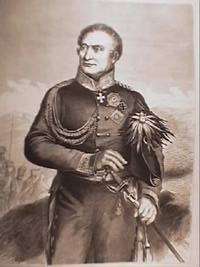 |
9th Brigade | no units present | - |
| 10th Brigade General-major Georg Dubislav Ludwig von Pirch |
2nd West Prussian Infantry Regiment, 3 battalions | - | |
| 7th Reserve Infantry Regiment, 3 battalions | - | ||
| 8th Silesian Landwehr Cavalry Regiment, 4 squadrons | - | ||
| 6-pounder Foot Artillery Battery Nr. 8 | 8 guns | ||
| 11th Brigade General-major Hans Ernst Karl, Graf von Zieten |
1st Silesian Infantry Regiment, 3 battalions | - | |
| 10th Reserve Infantry Regiment, 3 battalions | - | ||
| Silesian Schützen Battalion, 2 companies | - | ||
| 1st Silesian Hussar Regiment, 4 squadrons | - | ||
| 6-pounder Foot Artillery Battery Nr. 9 | 8 guns | ||
| 12th Brigade General-major Prince Augustus of Prussia |
2nd Silesian Infantry Regiment, 3 battalions | - | |
| 11th Reserve Infantry Regiment, 2 battalions | - | ||
| 7th Silesian Landwehr Cavalry Regiment, 4 squadrons | - | ||
| 6-pounder Foot Artillery Battery Nr. 21 | 8 guns | ||
| Cavalry Brigade Oberst Karl Georg Albrecht Ernst von Hake |
Silesian Cuirassier Regiment, 4 squadrons | - | |
| Silesian Uhlan Regiment, 4 squadrons | - | ||
| 6-pounder Horse Artillery Battery Nr. 8 | 8 guns | ||
| Cavalry Brigade General-major Friedrich Erhard von Röder |
East Prussian Cuirassier Regiment, 4 squadrons | - | |
| Brandenburg Cuirassier Regiment, 4 squadrons | - | ||
| II Corps Artillery Oberst Braun |
12-pounder Foot Artillery Battery Nr. 3 | 8 guns | |
| 12-pounder Foot Artillery Battery Nr. 6 | 8 guns | ||
| 6-pounder Foot Artillery Battery Nr. 11 | 8 guns | ||
| 6-pounder Foot Artillery Battery Nr. 13 | 8 guns | ||
| 6-pounder Horse Artillery Battery Nr. 9 | 8 guns | ||
| 6-pounder Horse Artillery Battery Nr. 10 | 8 guns | ||
| Howitzer Battery Nr. 1 | - | ||
French order of battle
Hearing about Blücher's advance to Champaubert, Napoleon ordered Ricard's division to rejoin the VI Corps. He reorganized Marshal MacDonald's infantry into the XI Corps and sent it south to face Schwarzenberg's Allied army.[38] Napoleon directed the following troops eastward to face Blücher: Friant's 1st Old Guard Division, Ney's two Young Guard divisions, Nansouty's 2nd and 3rd Guard Cavalry Divisions, and Saint-Germain's II Cavalry Corps. Jean Francois Leval's infantry division was marching north from Sézanne.[39] The fighting ended before Leval's soldiers arrived on the field.[40]
Notes
- Footnotes
- If Sacken had 12 guns for each of his 11 batteries, he would have had 132 guns available at Montmirail, instead of the 80–90 guns given by the sources.
- Citations
- Nafziger 2015, pp. 168–169.
- Petre 1994, p. 43.
- Petre 1994, pp. 52–53.
- Petre 1994, pp. 55–57.
- Nafziger 2015, pp. 601–602.
- Nafziger 2015, p. 552.
- Petre 1994, p. 105.
- Rothenberg 1980, pp. 201–201.
- Nafziger 2015, p. 554.
- Nafziger 2015, p. 551.
- Rothenberg 1980, p. 193.
- Rothenberg 1980, p. 195.
- Nafziger 2015, p. 527.
- Rothenberg 1980, p. 143.
- Petre 1994, p. 37.
- Chandler 1979, p. 87.
- Smith 1998, p. 494.
- Nafziger 2015, p. 597.
- Nafziger 2015, pp. 134–135.
- Pelet 1973, p. 511.
- Nafziger 2015, pp. 526–545, 575–580, 594–596, 599–600, 604–607.
- Chandler 1979, pp. 286–287.
- Nafziger 2015, p. 144.
- Petre 1994, p. 64.
- Petre 1994, p. 66.
- Nafziger 2015, p. 152.
- Nafziger 2015, pp. 602–603.
- Nafziger 2015, p. 149.
- Nafziger 2015, pp. 549–550, 602–603.
- Nafziger 2015, p. 146.
- Petre 1994, p. 61.
- Chandler 1979, pp. 90–91.
- Nafziger 2015, p. 159.
- Nafziger 2015, p. 153.
- Chandler 1979, pp. 458–459.
- Nafziger & 20125, p. 608–609.
- Nafziger 2015, pp. 608–609.
- Petre 1994, p. 67.
- Nafziger 2015, pp. 159–160.
- Nafziger 2015, p. 168.
References
- Chandler, David G. (1979). Dictionary of the Napoleonic Wars. New York, N.Y.: Macmillan. ISBN 0-02-523670-9.CS1 maint: ref=harv (link)
- Nafziger, George (2015). The End of Empire: Napoleon's 1814 Campaign. Solihull, UK: Helion & Company. ISBN 978-1-909982-96-3.CS1 maint: ref=harv (link)
- Pelet, Jean-Jacques (1973) [1811]. Horward, Donald D. (ed.). The French Campaign in Portugal 1810-1811. Minneapolis, MN: University of Minnesota Press. ISBN 0-8166-0658-7.CS1 maint: ref=harv (link)
- Petre, F. Loraine (1994) [1914]. Napoleon at Bay: 1814. London: Lionel Leventhal Ltd. ISBN 1-85367-163-0.CS1 maint: ref=harv (link)
- Rothenberg, Gunther (1980). The Art of War in the Age of Napoleon. Bloomington, Ind.: Indiana University Press. ISBN 0-253-31076-8.CS1 maint: ref=harv (link)
- Smith, Digby (1998). The Napoleonic Wars Data Book. London: Greenhill. ISBN 1-85367-276-9.CS1 maint: ref=harv (link)
